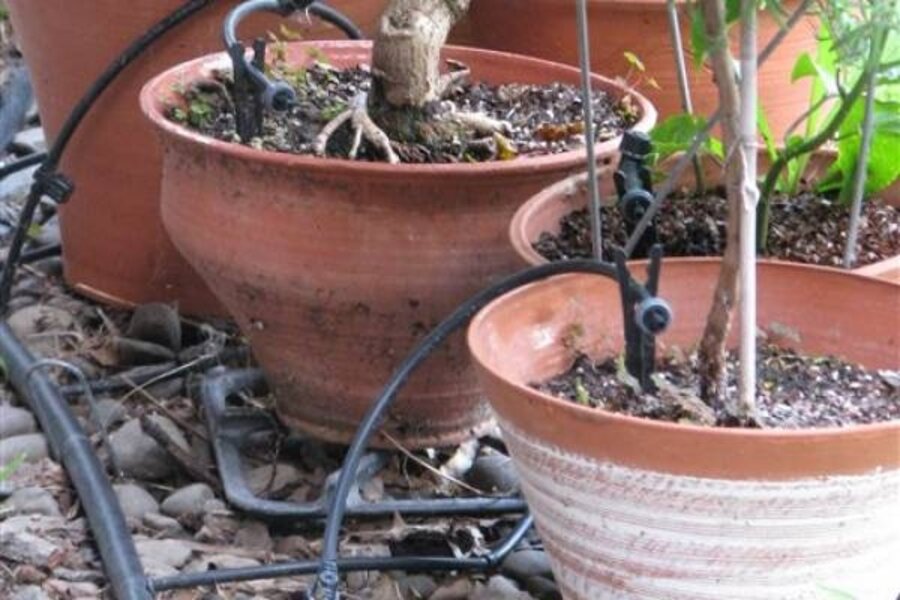How to care for plants when you're on vacation
Loading...
So you're going away on vacation? Your plants are not, and there's no reason for them to suffer in your absence. With a little pre-planning, they can thrive even as you stroll the streets of some exotic city or canoe pristine waters.
Unless your vacation is slated to go on for weeks and weeks, your main concern for your plants should be water. Two hot, sunny, summer days without water won't faze a tomato plant out in the garden but could kill a pot of marigolds. Your first job, then, is to identify which plants have similar thirsts.
Who's thirstiest?
With the exception of succulents, including cactii, which store water, the thirstiest plants will be those that are lush and growing in pots. The pots that dry out fastest are those that are porous, such as unglazed terra cotta, and those most bathed in air, such as hanging baskets and window boxes.
Other plants for which watering is most critical are any that you planted in the ground only within the past couple of weeks. Perhaps you recently planted out some broccoli or cabbage transplants for fall harvest, or some perennial flowers, trees, or shrubs that had been growing in pots. All these plants need help until sufficient roots venture out into surrounding soil.
Water such plants once a day for the first few days, then taper off to once every few days and finally once a week, at which time they can sit out your vacation untended.
Other plants in vegetable and flower beds, as well as established plants and even trees and shrubs you planted in spring, should be able to sit out your vacation happily enough without supplemental water. Sure, a weekly soaking would do them good, but they are unlikely to die without it.
Even potted plants can sit out your short vacation if moved to a shady spot shielded from wind, and perhaps stood in saucers with a bit a water in them. Not too long, though.
You can water from afar
So how can you get water to those plants that really need it, or tide any over during a long vacation?
The ideal is a reliable, green-thumbed friend already familiar with your plants. Short of that ideal, call in any other reliable friend or neighbor and introduce them to your plants before you leave. If you want to ease your plant sitter's chores, group together potted plants with similar watering needs, and have hose and watering cans standing ready and nearby.
Another option is to rig up something that automatically waters plants. One way is to group potted plants together and lay in each pot a small, commercially available drip tube which, in turn, feeds off a half-inch plastic pipe which, in turn, is connected to your spigot through an inexpensive water timer. The Oasis Self-Watering System has its own reservoir and series of tubes leading to plants.
You also can keep plants happily watered with various devices that wick water to dry soil. Aqua-Stake, for example, is a hollow, ceramic spike that's topped with a water reservoir; press the spike into the soil and water oozes out.
Water Siphons are similar, except the ceramic spike connects to a water reservoir via a tube. A length of thick polyester tope pushed up through the drainage hole of a flowerpot, the rope's end splayed out into the potting soil when the plant is potted up, could act similarly with its other end in a water reservoir.
(Drip tubes and ceramic waterers are available through such suppliers as www.charleysgreenhouse.com, www.dripworksusa.com, and www.urbanfarmerstore.com.)
The wicking concept has been expanded into self-watering pots (www.gardeners.com). Such pots have a reservoir, either underneath or built into the sides, from which water bleeds as needed into the potting soil. With any wicking system, periodically give the plants a good drenching from above to prevent buildup of fertilizer salts in the soil.
Give it a dry – no, wet – run
Test any automated watering system for a few weeks before you leave for vacation. Set up correctly, such systems do such a good job that you may decide to let them care for your plants all summer, whether or not you are away.
Editor’s note: For more on gardening, see the Monitor’s main gardening page. Our blog archive. Our RSS feed.
You may also want to visit Gardening With the Monitor on Flickr. If you join the group (it’s free), you can upload your garden photos. Join the discussions and get answers to your gardening questions.





